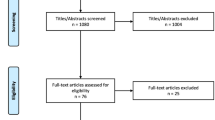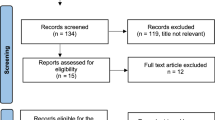Abstract
Objective
Levels of endogenous estrogen and SHBG are associated with risk of breast cancer among women who have never used hormone replacement therapy (HRT). We investigated these associations in both never and baseline users of HRT.
Methods
A nested case–control study was conducted within the prospective Danish population-based ‘Diet, Cancer, and Health’ cohort. During follow-up, 348 eligible cases were identified among 20,861 postmenopausal women and matched to 348 controls. Baseline serum samples were analyzed for estradiol, bioavailable estradiol, estrone, estrone sulfate, and SHBG. Conditional logistic regression yielded incidence rate ratios and 95 % confidence intervals for exposures analyzed continuously and categorically in models adjusted for potential confounders.
Results
Modest direct associations were identified between estrogen levels and breast cancer incidence among both never and baseline HRT users. Estrone and estrone sulfate were more consistently associated among both groups than estradiol. No association was found with SHBG.
Conclusion
Despite different hormonal profiles, higher serum estrogen levels were associated with a higher risk of breast cancer among both never and baseline HRT users. More studies are needed to support the findings for HRT users and to further investigate estrogen levels in relation to estrogen receptor-specific breast cancer and other histological and molecular subtypes.
Similar content being viewed by others

Abbreviations
- CI:
-
Confidence interval
- ERα:
-
Estrogen receptor α
- HRT:
-
Hormone replacement therapy
- IRR:
-
Incidence rate ratio
References
Key T, Appleby P, Barnes I, Reeves G, Endogenous Hormones and Breast Cancer Collaborative Group (2002) Endogenous sex hormones and breast cancer in postmenopausal women: reanalysis of nine prospective studies. J Natl Cancer Inst 94:606–616
Manjer J, Johansson R, Berglund G et al (2003) Postmenopausal breast cancer risk in relation to sex steroid hormones, prolactin and SHBG (Sweden). Cancer Causes Control 14:599–607
Missmer SA, Eliassen AH, Barbieri RL, Hankinson SE (2004) Endogenous estrogen, androgen, and progesterone concentrations and breast cancer risk among postmenopausal women. J Natl Cancer Inst 96:1856–1865
Zeleniuch-Jacquotte A, Shore RE, Koenig KL et al (2004) Postmenopausal levels of oestrogen, androgen, and SHBG and breast cancer: long-term results of a prospective study. Br J Cancer 90:153–159
Kaaks R, Rinaldi S, Key TJ et al (2005) Postmenopausal serum androgens, oestrogens and breast cancer risk: the European prospective investigation into cancer and nutrition. Endocr Relat Cancer 12:1071–1082
Sieri S, Krogh V, Bolelli G et al (2009) Sex hormone levels, breast cancer risk, and cancer receptor status in postmenopausal women: the ORDET cohort. Cancer Epidemiol Biomarkers Prev 18:169–176
Baglietto L, Severi G, English DR et al (2010) Circulating steroid hormone levels and risk of breast cancer for postmenopausal women. Cancer Epidemiol Biomarkers Prev 19:492–502
Fuhrman BJ, Schairer C, Gail MH et al (2012) Estrogen metabolism and risk of breast cancer in postmenopausal women. J Natl Cancer Inst 104:326–339
Althuis MD, Fergenbaum JH, Garcia-Closas M, Brinton LA, Madigan MP, Sherman ME (2004) Etiology of hormone receptor-defined breast cancer: a systematic review of the literature. Cancer Epidemiol Biomarkers Prev 13:1558–1568
Zeleniuch-Jacquotte A, Toniolo P, Levitz M et al (1995) Endogenous estrogens and risk of breast cancer by estrogen receptor status: a prospective study in postmenopausal women. Cancer Epidemiol Biomarkers Prev 4:857–860
Cummings SR, Lee JS, Lui LY, Stone K, Ljung BM, Cauleys JA (2005) Sex hormones, risk factors, and risk of estrogen receptor-positive breast cancer in older women: a long-term prospective study. Cancer Epidemiol Biomarkers Prev 14:1047–1051
Farhat GN, Cummings SR, Chlebowski RT et al (2011) Sex hormone levels and risks of estrogen receptor-negative and estrogen receptor-positive breast cancers. J Natl Cancer Inst 103:562–570
James RE, Lukanova A, Dossus L et al (2011) Postmenopausal serum sex steroids and risk of hormone receptor-positive and -negative breast cancer: a nested case-control study. Cancer Prev Res (Phila) 4:1626–1635
Beral V, Million Women Study Collaborators (2003) Breast cancer and hormone-replacement therapy in the Million Women Study. Lancet 362:419–427
Collaborative Group on Hormonal Factors in Breast Cancer (1997) Breast cancer and hormone replacement therapy: collaborative reanalysis of data from 51 epidemiological studies of 52,705 women with breast cancer and 108,411 women without breast cancer. Lancet 350:1047–1059
Banks E, Canfell K, Reeves G (2008) HRT and breast cancer: recent findings in the context of the evidence to date. Womens Health (Lond Engl) 4:427–431
Tworoger SS, Missmer SA, Barbieri RL, Willett WC, Colditz GA, Hankinson SE (2005) Plasma sex hormone concentrations and subsequent risk of breast cancer among women using postmenopausal hormones. J Natl Cancer Inst 97:595–602
Statens Serum Institut (1993) Kapitel 12: Kønshormoner. In: Jørgensen BB, Arends J, Espersen F (eds) Håndbog ‘93. Denmark, pp 281–284
Edlefsen KL, Jackson RD, Prentice RL et al (2010) The effects of postmenopausal hormone therapy on serum estrogen, progesterone, and sex hormone-binding globulin levels in healthy postmenopausal women. Menopause 17:622–629
Tjonneland A, Olsen A, Boll K et al (2007) Study design, exposure variables, and socioeconomic determinants of participation in Diet, Cancer and Health: a population-based prospective cohort study of 57,053 men and women in Denmark. Scand J Public Health 35:432–441
Tjonneland AM, Overvad OK (2000) Diet, cancer and health—a population study and establishment of a biological bank in Denmark]. Ugeskr Laeger 162:350–354
Tjonneland A, Overvad K, Haraldsdottir J, Bang S, Ewertz M, Jensen OM (1991) Validation of a semiquantitative food frequency questionnaire developed in Denmark. Int J Epidemiol 20:906–912
Jensen AR, Overgaard J, Storm HH (2002) Validity of breast cancer in the Danish Cancer Registry. A study based on clinical records from one county in Denmark. Eur J Cancer Prev 11:359–364
Fischerman K, Mouridsen HT (1988) Danish Breast Cancer Cooperative Group (DBCG). Structure and results of the organization. Acta Oncol 27:593–596
Emment Y, Collins WP (1972) Radioimmunoassay of oestrone and oestradiol in human plasma. Acta Endocrinol (Copenh) 69:567–582
Franz C, Watson D, Longcope C (1979) Estrone sulfate and dehydroepiandrosterone sulfate concentrations in normal subjects and men with cirrhosis. Steroids 34:563–573
Tremblay RR, Dube JY (1974) Plasma concentrations of free and non-TeBG bound testosterone in women on oral contraceptives. Contraception 10:599–605
Cornelisse MM, Bennett PE, Christiansen M et al (1994) Sex hormone binding globulin phenotypes: their detection and distribution in healthy adults and in different clinical conditions. Clin Chim Acta 225:115–121
Prentice RL, Kalbfleisch JD, Peterson AV Jr, Flournoy N, Farewell VT, Breslow NE (1978) The analysis of failure times in the presence of competing risks. Biometrics 34:541–554
Greenland S (1995) Avoiding power loss associated with categorization and ordinal scores in dose-response and trend analysis. Epidemiology 6:450–454
Greenland S (1995) Dose-response and trend analysis in epidemiology: alternatives to categorical analysis. Epidemiology 6:356–365
Storm HH, Michelsen EV, Clemmensen IH, Pihl J (1997) The Danish Cancer Registry—history, content, quality and use. Dan Med Bull 44:535–539
Moller S, Jensen MB, Ejlertsen B et al (2008) The clinical database and the treatment guidelines of the Danish Breast Cancer Cooperative Group (DBCG); its 30-years experience and future promise. Acta Oncol 47:506–524
Tjonneland A, Christensen J, Thomsen BL et al (2004) Hormone replacement therapy in relation to breast carcinoma incidence rate ratios: a prospective Danish cohort study. Cancer 100:2328–2337
Kraemer GR, Kraemer RR, Ogden BW, Kilpatrick RE, Gimpel TL, Castracane VD (2003) Variability of serum estrogens among postmenopausal women treated with the same transdermal estrogen therapy and the effect on androgens and sex hormone binding globulin. Fertil Steril 79:534–542
Fortunati N, Catalano MG, Boccuzzi G, Frairia R (2010) Sex Hormone-Binding Globulin (SHBG), estradiol and breast cancer. Mol Cell Endocrinol 316:86–92
Nachtigall LE, Raju U, Banerjee S, Wan L, Levitz M (2000) Serum estradiol-binding profiles in postmenopausal women undergoing three common estrogen replacement therapies: associations with sex hormone-binding globulin, estradiol, and estrone levels. Menopause 7:243–250
Acknowledgments
The study was supported financially by the Danish Cancer Society (grant DP 00027). The authors thank the Department of Clinical Biochemistry and Immunology at Statens Serum Institut for analyzing serum samples and Katja Boll and Jytte Fogh Larsen for their help in data collection.
Conflict of interest
The authors declare that they have no conflict of interest.
Author information
Authors and Affiliations
Corresponding author
Rights and permissions
About this article
Cite this article
Würtz, A.M.L., Tjønneland, A., Christensen, J. et al. Serum estrogen and SHBG levels and breast cancer incidence among users and never users of hormone replacement therapy. Cancer Causes Control 23, 1711–1720 (2012). https://doi.org/10.1007/s10552-012-0050-7
Received:
Accepted:
Published:
Issue Date:
DOI: https://doi.org/10.1007/s10552-012-0050-7



